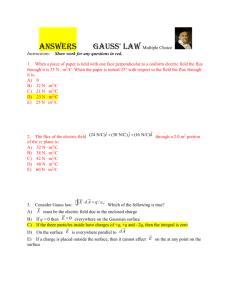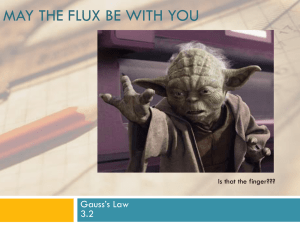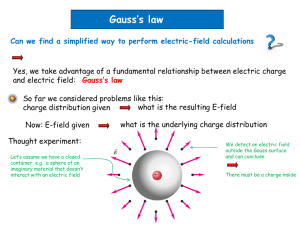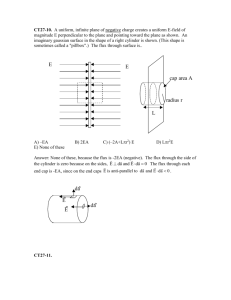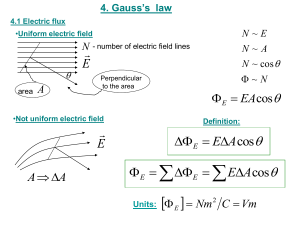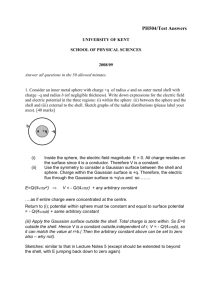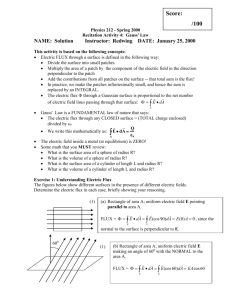Applications of Gauss`s law
advertisement
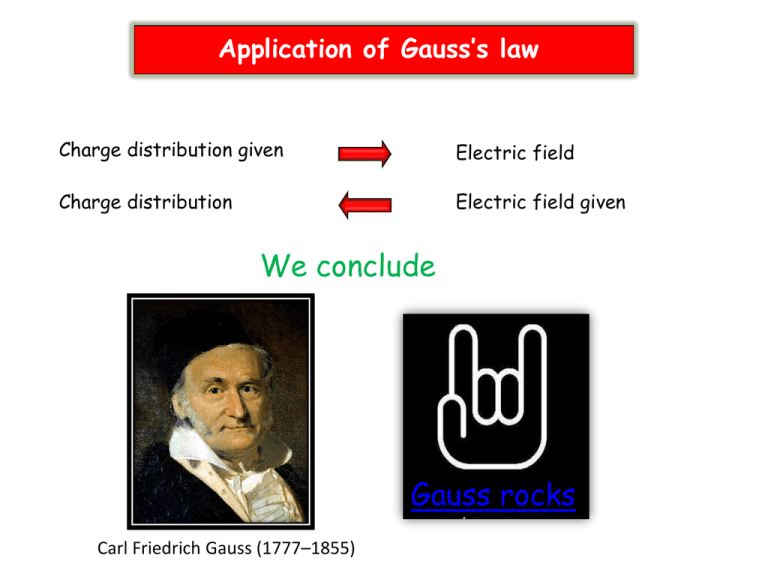
Application of Gauss’s law Charge distribution given Electric field Charge distribution Electric field given We conclude Gauss rocks Carl Friedrich Gauss (1777–1855) Let’s practice some examples first for the case Charge distribution given R Electric field 1 Electric field outside the sphere We almost solved this problem before Use the symmetry of charge distribution good idea to use a Gauss sphere Positive charge Q on a conducting sphere of radius R charge will be on the surface of the sphere, inside the sphere no charge E with r > R Q 0 with E normal to surface of Gauss sphere and constant on surface Q 2 E d A E E d A E 4 r r E dA 0 E Q 4 0 r 2 r is a running variable because we can apply the calculation for any r>R Electric field inside the sphere Gauss sphere with r<R no net charge inside the Gauss sphere E R r E dA0 r with r < R consistent with 1.0 0.8 0.6 0 2 E(r)4 R /Q 2 0.4 0.2 0.0 0 1 2 r/R 3 4 E 0 What changes if the sphere is insulating and homogeneously charged Homogeneously charged sphere with charge density Electric field outside the sphere We see the same enclosed net charge 1 r>R + + ++ + + + + +R + + + + + + + ++ + + + + + ++ +r<R+ + + + + + + ++ + ++ + + + E E dA E r Q 4 0 r 2 with r > R However for r < R we now enclose r-dependent net charge charge enclosed by Gauss sphere of r<R 4 3 r3 Q(r ) r Q 3 3 R 3 1.0 0.8 Qr E E d A 3 R 0 r 0.6 0 2 E(r)4 R /Q 3Q 4 R 3 0.4 0.2 with r < R 0.0 0 1 2 r/R 3 4 Qr 3 E 4 r 0 R3 Qr E 4 0 R 3 2 Let’s revisit a question we answered before now using Gauss’s law as new tool Electric field between oppositely charged large parallel plates homogeneity of the field is our input from symmetry ------------------------------------------------Charge density Q/ A R +++++++++++++++++++++++++++++++ We use a cylinder as a Gaussian surface. This is just one choice out of many possible 2 R E E d A E d A E d A E R 2 0 no contribution from the side or bottom E 0 That was easy, thank you Carl Friederich Obviously our choice of the Gaussian surface was arbitrary For example a box would work as good as the cylinder did a b E E 0 E d A E ab ab 0 Field lines at the surface of a charged conductor are always perpendicular to the surface (otherwise an in-plane component would move the charges) We can transfer above considerations to derive the general result for the electric field on an arbitrarily shaped conducting surface conducting surface with charge density E 0 E indicates that on the conducting surface E is perpendicular Clicker question Considering the two situation depicted in the figures. What can you say about the relation between the flux through the surfaces for the left and the right figure? Assume that a “+” represents the charge of a proton and a “-” represents the charge of an electron. The surface area of the sphere is twice the surface area of the cylinder. - + + ++ + - -+ ++ + ++ +++ A) The flux through the sphere is twice the flux through the cylinder B) I need to calculate the flux integral over both surfaces to decide C) The flux is identical D) The flux is zero in both cases E) The flux sucks
